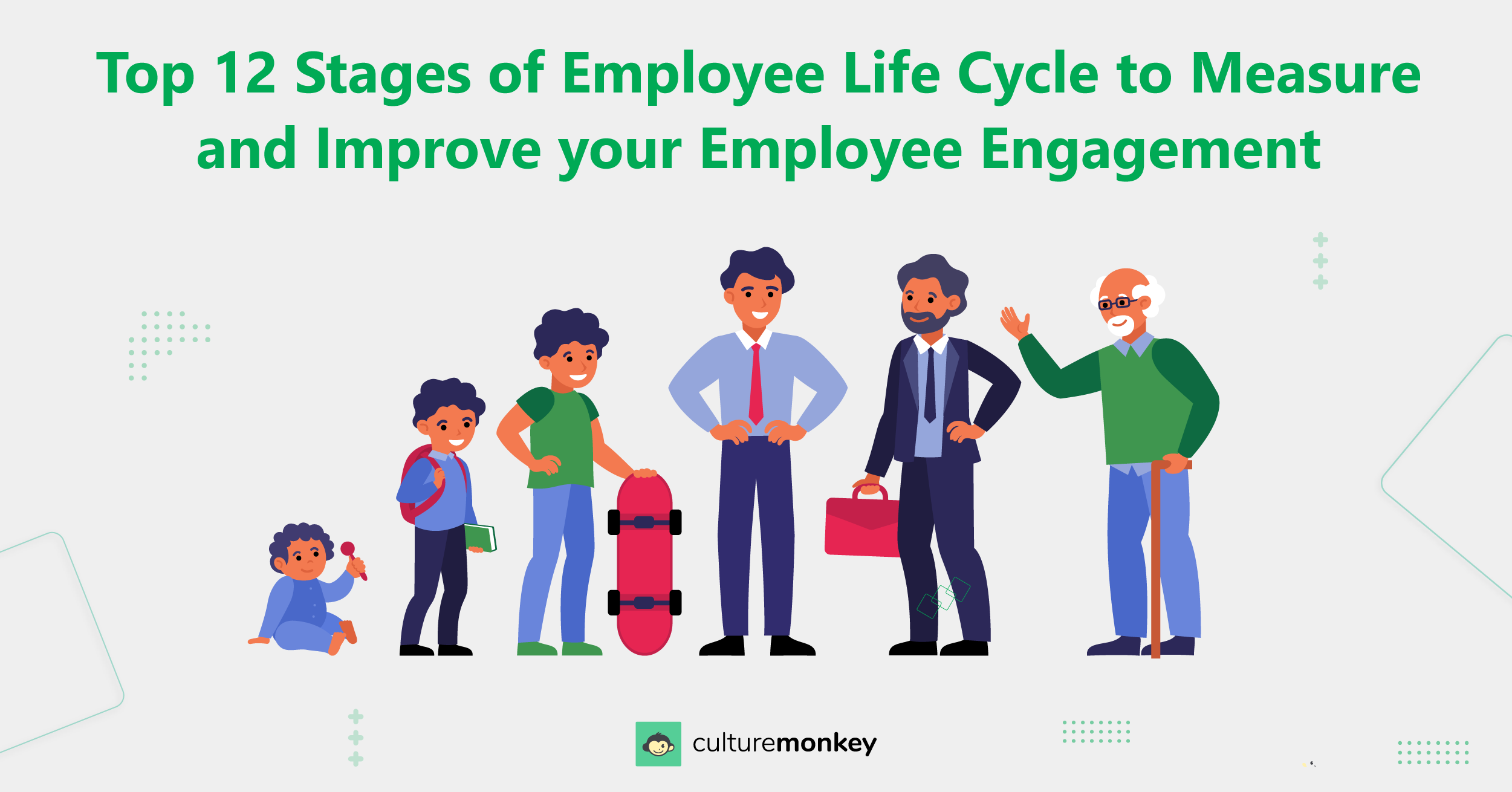Top 12 stages of employee life cycle to measure and improve your employee engagement

The people leaders and C-suite who run the organization know how crucial a team is for their success.
Although everyone says employees are an extended part of the family, at times, they fail to measure and improve their employees’ engagement properly, which ultimately leads to attrition.
A Gallup study states high engagement culture brings higher productivity and 21% higher profits. So the key to attracting and retaining your top employees is to focus on improving employee engagement in every step of the employee life cycle. Let’s cover just that in our article here.
Table of contents:-
- What is employee life cycle model?
- What is employee life cycle management?
- What are the stages of employee life cycle model?
- Showcase potential possibilities by practicing employee life cycle
What is employee life cycle?

The employee life cycle model identifies and represents multiple crucial stages of an employee throughout their life cycle with the organization. The different stages of the employee life cycle anticipate a well-defined strategy for employers can have a smooth transition throughout the employee's journey. This helps create a positive work atmosphere, resulting in better performance and improved employee experience.
Still, the term employee engagement pop-ups in various stages of the employee life cycle with different meanings, depending on who you ask. Generally, it describes employees who happily work while achieving their company values, not just because they get paid but invested, emotionally or otherwise.
A business that encourages and supports employee engagement throughout the employee life cycle model will perform better overall, including improved loyalty, increased customer service, and better adoption of the company's initiative.
Research states that 39% of workers will work hard to increase productivity if they are happy. Acknowledging and enhancing the life cycle begins from the moment a potential joiner first learns about the company until the time they become an alumnus; It is essential to measure and improve their engagement throughout their life cycle to make the necessary organizational changes.
In short, the employee life cycle is a model that recognizes different stages of an employee's advances in an organization, from awareness and onboarding to the alumni, the final stage.
What is employee life cycle management?
Employee life cycle management is a crucial yet often overlooked part of HR strategy. But why is managing the employee life cycle important? Effectively managing an employee life cycle model helps to ensure that every employee engages and is supported throughout their employment and their performance is monitored and improved. These ultimately help to improve employee experience, morale, productivity and make the organization more successful.
Employee feedback
Employee feedback helps identify improvement areas and provides insight that best supports every employee's journey. By understanding the anonymous feedback provided, organizations and HR teams can make better-informed decisions in regard to employee retention, recruitment, and professional development. It also allows organizations to measure employee engagement and morale, which are the key indicators of organizational performance.
Setting objectives
Setting objectives for every employee helps define clear expectations and provides them with a path to success. It also ensures that employees are held accountable for their work and that the organization is able to track progress and provide feedback.
Objectives motivate and engage employees, providing direction and focusing on growth opportunities. By setting objectives, HR teams and organizations help to create an environment of trust and measure team morale frequently leads to higher levels of performance and productivity.
Closely monitor growth
A successful employee life cycle strategy requires tracking and measuring employee growth on an ongoing basis. This means understanding the impact of new initiatives, evaluating the effectiveness of training programs, and reviewing metrics that indicate employee development.
By closely monitoring growth, organizations can provide employees with the necessary support and resources to reach their objectives. And it allows organizations to identify areas of improvement and better understand how to best support employee performance and growth.
Development opportunities
Providing development opportunities help foster a sense of purpose and accomplishment while also enabling to enhance their employee engagement and experience, skills and knowledge. Career development opportunities allow employees to grow, stay engaged and become more productive, and organizations can benefit from increased morale, leading to improved employee satisfaction and loyalty.
Establishing communication
Having effective communication across the organization helps build trust, increases efficiency and boosts collaboration. Proper communication establishes a strong foundation for better decision-making and understanding of company goals. It also helps to reduce misunderstandings, create a more productive working environment, and improve team morale.
Acknowledging and addressing employee issues in a timely manner is critical for a positive employee experience. It allows HR to understand employee needs better and keep them motivated and engaged throughout their life cycle.
What are the stages of employee life cycle model?
A comprehensive employee life cycle model helps to identify each stage’s needs and outline the perfect strategy for dealing with them that positively impacts the organization. This helps to ensure that employees are engaged, productive, and motivated throughout their life cycles, resulting in a successful and harmonious work environment.
So certain employee life cycle stages overlap with HR's core responsibilities, and it is essential for HRs to know about it as it will help them understand how well employees are doing in their roles and where they need help. Some models focus on the 5–6 stages of the life cycle.
Still, here, we are taking a deeper dive to look at 12 crucial stages of the employee life cycle model, aiming at how to optimize and measure employees' experience along the way:
01. Attracting
The employee life cycle stages don't begin with the onboarding process; it starts even before there is no contact between you and the potential candidate. There is never a shortage of top talent out there in the market, although attracting the right person at the onset is critical in the ongoing competitive job market. Both millennials and gen z are increasingly selective about starting their journey with the positive hiring process.
Well, according to a study, 80% of employees will choose a job with perks over a similar position in a different company that offers 30% more salary but zero benefits. Yes, workplace perks aren't the only thing that new employees look for; they also ensure that your company has a fostering business culture and positive employees who spread the word about how great it is to work with your company.
So, you must start working on the significant aspect—listening to feedback and acting on it promptly to improve your employee engagement throughout your employee life cycle phases.
Make sure you are active on social media like LinkedIn or Glassdoor and have a positive reputation for showcasing your company.
To focus on attracting the right candidate who is also a top talent in their field, you must create an employer brand with the company's values, vision, and mission while displaying your company as a great place to work.
02. Interviewing
Interviewing/Screening candidates is an integral step of the employee life cycle and selection process. The interview allows employers and the candidate to ask questions to each other to know whether the role suits the applicant's skills, personality, experience and see the culture fit.
So, the interview process is not all about determining the candidate's qualification for the role but also allows the candidate to assess whether your company's culture and the job you offer are suitable for their career.
Though preparing for an interview can help to clarify the job responsibilities, and 47% of potential candidates fail in interviews due to a lack of knowledge or information about the company, the employer should be able to help the candidates with the information needed during the interview.
03. Recruiting
As mentioned earlier, it is a competitive world; on average, 118 employees apply for one job, and 20% get into an interview. So, if you are wondering how many candidates get into interviews, it's only 1 in 7.
When the recruiting process begins, the potential employee will be more familiar with your company culture and the job description and will aspire to join your company if they consider the current employees' benefits and your network while seeking qualified new hires.
An average of 30–45 minutes of time isn't enough to recruit a candidate. They should perform specific tasks in which they should excel, and then there is employee referral, which is also one of the finest recruitment strategies. This is where the employee net promoter score kicks in.
When your organization's promoters refer and recommend their friends and family to work for you, it is a bigger win for you in your recruitment process as it saves tons of money on your hiring costs.
Besides those two, internships and recruitment events are some channels that allow the execution of a smooth recruitment process.
The HRs and existing employees are also most effective during the hiring screen. When an employee is in your company for quite some time, as a professional, they are more likely to know people who will be a good fit for the team and the company.
04. Onboarding
Onboarding is a critical part of an employee life cycle, where you have to ensure your protocols are in place, walk them through your expectations, and listen to feedback as soon as they start.
68% of new employees feel their experience as a job candidate directly refers to how the company treats its employees. Nearly 10% of employees leave the job due to poor new hire (onboarding) experience.
The new hires generally have higher expectations for logistics, communication, and onboarding processes; if not fulfilled, they usually suffer lower engagement rates. This is where technology can help you automatically collect honest feedback through onboarding surveys.
This feedback lets you see what most valuable asset i.e. valuable points, your new hires can provide for the company with a fresh perspective. Also, addressing queries during an employee's onboarding process can allow you to address concerns before they become more significant.
05. Engaging
Soon as the excitement of a new job or "workplace honeymoon phase" wears off (typically within six months), the employees acknowledge that they are working in a routine. Some even show signs like a lack of motivation, boredom, and frustration when their blissful phase ends.
The pandemic wasn't helpful either for employee engagement or the entire employee life cycle, for that matter. 2021 was the first time in the decade that the percentage of engaged employees dropped year-over-year to 34%, and 14% were directly disengaged.
Low engagement comes with poor communication, misunderstanding, and a lack of recognition. More than ever, several companies practice employee engagement as part of the employee life cycle because engaged employees will lead to increased performance, employee performance, organizational success, enthusiastic employees, and long-term employee retention.
This is why it is essential to run engagement surveys on a regular basis and not to depend on annual engagement surveys, where before you know and could take action to resolve the issue, the employee must have left the organization.
06. Developing
Everyone requires fresh challenges, and so does an employee. They always look forward to growing and learning in their employee life cycle once they establish themselves in the company.
Even when your business is small and doesn't have more room to improve the employee life cycle, you can give the employees new projects and responsibilities to push them to grow within their respective roles. Doing so can increase employee experience, production, and engagement.
When they don't feel any progression at the workplace, they are more likely to look for it elsewhere, which is also why 72% of employees are looking for new job opportunities.
So, make sure you encourage and support your employees to create professional development that allows them to boost and grow their skills during the employee life cycle with the company so they can become a top talent in their field. Along with frequently assisting them in completing tasks and ensuring they learn something new. Remember, regular pay raises and rewards can go a long way.
07. Retaining
Employee quitting is a natural part of the employee life cycle, but retaining them requires skills, and there are things you can improve to retain the best performers. A flawed company culture will result in high employee turnover, with having to replace employees more frequently. On average, a company experiences an 18% employee turnover rate yearly.
Improving the employee life cycle doesn't just cut the employee turnover rate. It also helps to minimize other damages to the organization and enhance the business's key metrics—developing morale, cost reductions, increased revenue, improved culture, better customer experience, attractive employee life cycle, training efficiency, and more.
You regularly need to start a conversation and receive feedback via surveys to solve your employees’ issues throughout their life cycle with your organization. Listen to their suggestions, empower them to improve their work, keep them engaged, and make sure they are comfortable in their routine.
08. Recognizing
Yes, everybody works for a steady paycheck and good benefits. Still, recognition in the workplace indicates to employees that their company values them and their contributions to the company's overall growth.
44% of employees want to switch jobs since they are not receiving enough recognition, while 66% of employees who feel more recognized are less likely to look for a new job.
Recognizing and rewarding will boost employees' commitment to their team throughout the employee life cycle. As a people leader, it is essential that you encourage your managers to recognize good work by offering employees a way to acknowledge it.
Motivating employees is vital when you want your organization to grow. It also helps to build a sense of security among employees in their value to the company. 53% of employees admit they will stay longer at their company if they feel more appreciation from their boss. Make sure you recognize the game.
09. Off-boarding
Employees don't want to be with a company that doesn't offboard them nicely, so a proper offboarding mechanism is an essential part of the employee life cycle scheme. When an employee leaves, the most they expect is a friendly offboarding instead of escorting them out as soon as they turn in their notice.
It would be best if you have a mechanism where a smooth transition of responsibilities takes place so that the employee can cross-train anyone who will effectively take over their project.
Make sure you are peaceable throughout the employee life cycle and until the preparation of off-boarding employees' payroll and benefits.
10. Separating
Employees should leave your company with fond memories, good intentions and wish their peers well. Make time to know the reasons behind your employee separation, understand them, and make sure whether you need to change certain things that your employee life cycle covers.
Obtaining honest feedback will help to improve your organization and make it a better workplace. Arrange a cordial goodbye lunch and honour their time at your company. When the offboarding employee appreciates your work to improve the employee life cycle, they will spread the positive word. 52% of job hunters seek Glassdoor reviews to identify top companies with great cultures and values for their employees.
11. Exit formalities
The employee's resignation can be for various reasons, including new employment, personal reasons, or retirement, but make sure the exit formalities are as strategic as the onboarding procedure.
When an employee resigns, it can impact the rest of the team like a domino effect, and HR professionals have to ensure the person going doesn't disturb the company’s momentum.
A crucial element of the employee life cycle is listening to the employee's feedback during their departure, yet many companies ignore listening to them.
Have an exit interview, manage it professionally and appropriately, analyze the insights from the departing employee and appreciate them for the honest feedback. The feedback gathered from the parting employee will help you make changes in your employee life cycle and employer branding. Showing you will listen to employees even at the end reveals your commitment to employee engagement.
12. Alumni
The employee life cycle is always dynamic, so an employee's departure doesn't always mean the end of the relationship. The company's former employees may work for your customer, and someone can ask for their opinion on your company, or they can come back to work with you in the future.
Don't overlook the alumni as the final stage of the employee life cycle; use social media to stay connected with former peers and hear their comments. The feedback will vary depending on where they are, so be prepared to listen so you can also work accordingly for future employees.
Practice employee life cycle with cycle with the right tool!
Modern employees are looking for innovative policies that allow them to stay longer, so guarantee that you focus on the employee life cycle while comprehending their journey. Don't limit yourself within your organization; look outside for new employee life cycle trends that you can initiate in your company.
This is where a platform like CultureMonkey can step in to help you automate your employee life cycle surveys. CultureMonkey helps you to send automated employee surveys to your people from the onboarding stage till the separation stage without much manual intervention.
Enhance your operations by investing in employee life cycle software to support your collection and implementation of feedback so you can retain and engage your employees in the long run.



